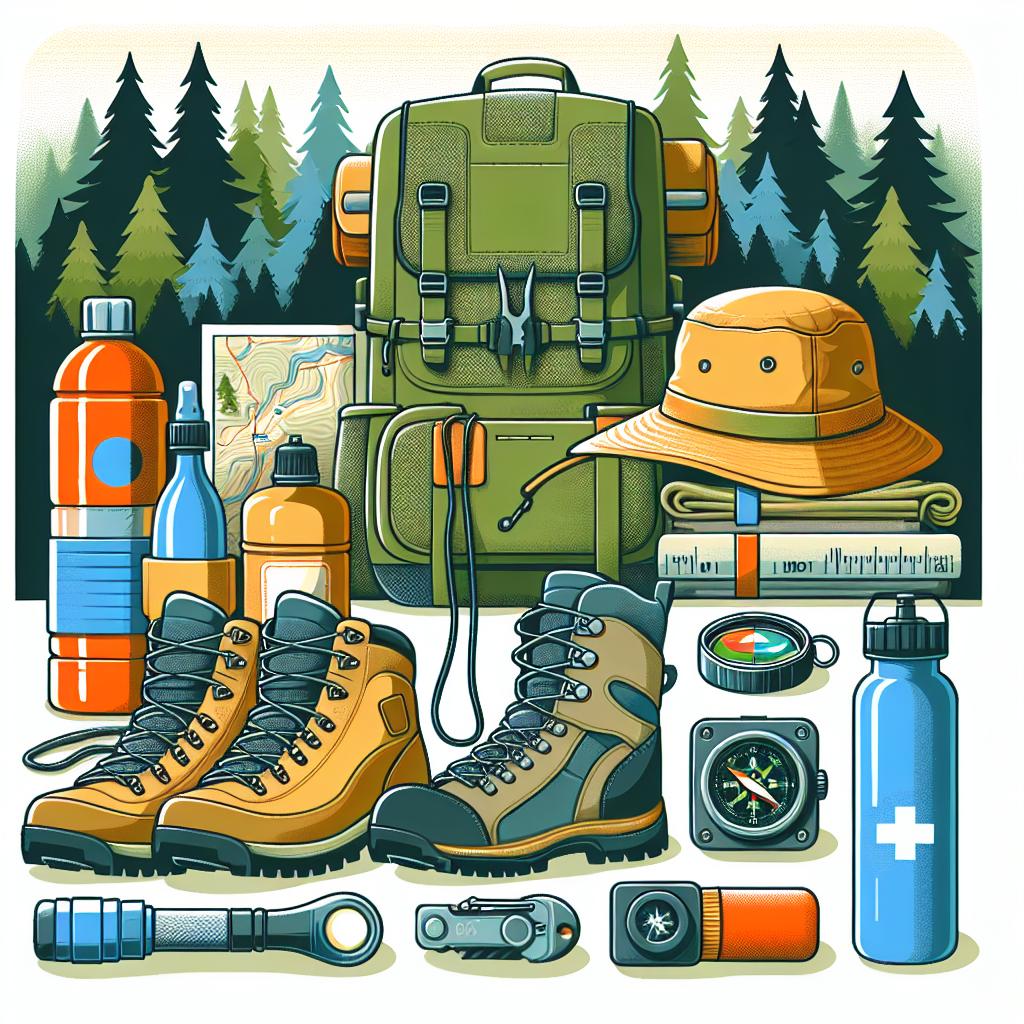Imagine standing at the trailhead, the crisp morning air filling your lungs, the world around you alive with the symphony of rustling leaves and distant bird calls. Before you stretches a labyrinth of paths, each winding its way through the wilderness, each promising its own unique adventure. But how do you decide which trail to tread? Choosing the right hiking trail can be as exhilarating—and as daunting—as the hike itself. Whether you’re a seasoned hiker in search of your next challenge or a curious novice eager to embrace nature’s wonders, this guide will illuminate the key factors to consider, helping you navigate the myriad of options and select the perfect path for your journey. Let’s embark together on this quest for the ideal trail, ensuring your next hike is not just a walk, but a walk to remember.

Researching Trail Difficulty and Terrain
To accurately gauge the difficulty of a hiking trail, consider aspects such as the trail’s **length**, **elevation gain**, and **terrain type**. Beginners might look for trails with minimal elevation change, while seasoned hikers may find delight in steeper ascents. Pay attention to trail ratings, often categorized as easy, moderate, or difficult, based on these factors. Helpful resources include guidebooks, online platforms, and hiker reviews to get a feel for what you might encounter on the trail.
- Length: Short trails for quick hikes or long, multi-day adventures.
- Elevation Gain: Gentle slopes vs. steep climbs.
- Terrain Type: Forest paths, rocky scrambles, or paved walkways.
The trail’s terrain can significantly impact your hiking experience. It’s essential to know what kind of ground you’ll be covering to ensure you’re well-prepared and equipped. For instance, a trail mainly composed of loose gravel might require sturdier footwear compared to a well-defined dirt path. Moreover, understanding trail conditions such as potential water crossings or seasonal snow can help in pre-planning for safety and comfort.
| Terrain Type | Ideal Gear |
|---|---|
| Rocky | Hiking boots with good ankle support |
| Muddy | Waterproof shoes |
| Forest | Trail shoes with good grip |
| Sandy | Gaiters to keep sand out |


Understanding Weather Conditions and Seasonal Factors
When selecting a hiking trail, it’s essential to consider weather conditions and seasonal factors. **Weather conditions** can drastically impact the hiking experience. For example, trails that might be easy to navigate in spring could become treacherous with summer heat or winter snow. Understanding the local climate patterns, such as average temperatures, precipitation rates, and sun exposure, can help you prepare adequately. Furthermore, certain trails might have specific advisories during particular seasons, such as springtime flooding or fall foliage crowds.
**Seasonal changes** also affect trail accessibility and scenery. During autumn, the colorful foliage can enhance your hike, but falling temperatures require additional gear like insulated jackets and thermal layers. In contrast, summer hikes might demand lightweight clothing, ample hydration, and sun protection. Here’s a quick reference to common trails and their optimal seasons:
| Trail | Optimal Season | Key Considerations |
|---|---|---|
| Mountain Peak | Summer | High Sun Exposure, Carry Extra Water |
| Forest Trail | Autumn | Cool Weather, Stunning Foliage |
| Desert Path | Spring | Mild Temperatures, Blooming Flora |
By aligning your trail choice with the season, you not only enhance safety but also ensure a more enjoyable and memorable hiking experience.


Essential Gear and Clothing for Safe Hiking
When venturing out into the wilderness, ensuring you have the right gear and clothing is crucial for both safety and comfort. Start with the basics: a weather-appropriate jacket, durable hiking boots, and **moisture-wicking clothing**. Layers are your best friend; they allow you to adjust to the fluctuating temperatures and keep you warm and dry. **A wide-brimmed hat** and **sunglasses** can protect you from the sun, while a **reliable backpack** with a rain cover will keep your essentials dry. Remember to pack a **first aid kit**, **multi-tool**, and a **map or GPS device** to navigate the terrain safely.
Additional must-haves include a source of light such as a **headlamp or flashlight**, a whistle for emergencies, and a **hydration system**. Many hikers prefer carrying water bladders for ease of access while on the move. Also, stock up on energy-rich snacks like nuts, dried fruit, and protein bars to keep your energy levels up. Here’s a quick table for essential items:
| Item | Purpose |
| Jacket | Weather Protection |
| Hiking Boots | Foot Support & Protection |
| Headlamp | Visibility in Low Light |
| First Aid Kit | Emergency Treatment |
Assessing Trail Length and Duration for Your Skill Level
When evaluating the length and duration of a hiking trail, it is crucial to take your own skill level into consideration. For beginners, starting with shorter trails, such as those less than 3 miles, can help you build confidence and endurance without overexertion. **Intermediate hikers** might be comfortable tackling trails ranging from 3 to 7 miles, while **advanced hikers** could aim for those exceeding 7 miles, often involving more complex terrains and elevation changes.
- Beginners: Opt for trails less than 3 miles.
- Intermediate: Explore trails between 3 to 7 miles.
- Advanced: Venture on trails over 7 miles.
Equally important is the time you plan to spend on the trail. Shorter trails can generally be completed within a few hours, making them perfect for a morning or afternoon hike. However, longer trails could require a full day or sometimes even overnight camping. Consider the elevation gain as well, as a trail with significant vertical ascent will take longer and be more strenuous. It’s advisable to refer to trail guides that often provide estimates of the time required to complete a trail based on average walking speed.
| Trail Length | Estimated Completion Time |
|---|---|
| Less than 3 miles | 1-3 hours |
| 3-7 miles | 3-6 hours |
| Over 7 miles | 6+ hours or overnight |
Q&A
Q&A: How to Choose the Right Hiking Trail
Q1: What are the most important factors to consider when choosing a hiking trail?
A1: Choosing the right hiking trail hinges on several key factors. First, assess your fitness level and experience. Novices should seek out shorter, well-marked trails with moderate terrain, while seasoned hikers might crave more challenging, rugged paths. Second, consider the trail’s distance and elevation gain, as these will greatly affect the hike’s difficulty and duration. Lastly, research the trail’s conditions and highlights, such as wildlife, scenery, or historical landmarks, to ensure the hike aligns with your interests and expectations.
Q2: How can I determine the difficulty level of a trail?
A2: Trail difficulty is often categorized by length, elevation change, and terrain. Look for ratings like “easy,” “moderate,” or “strenuous” provided by park services or hiking guides. Elevation change is a strong indicator: trails with significant climbs will be more challenging. Additionally, trail surfaces vary; rocky, muddy, or uneven paths can add complexity. Websites like AllTrails and Hiking Project offer user reviews and detailed trail descriptions, helping you gauge what to expect.
Q3: Are there specific resources or tools that can help me select a trail?
A3: Absolutely! Online platforms like AllTrails, Hiking Project, and TrailLink offer comprehensive databases with user reviews, photos, and maps. Many also provide GPS tracking features and difficulty ratings. Local outdoor clubs, ranger stations, and visitor centers are invaluable for up-to-date trail information and personalized recommendations. hiking apps and social media groups can connect you with a community of fellow hikers who can share insights and tips.
Q4: How important is it to check the weather before selecting a trail?
A4: Extremely important! Weather conditions can drastically affect trail safety and enjoyment. Rain can make trails slippery and treacherous, while extreme temperatures can pose significant health risks. Always check the forecast for the day of your hike, and be prepared for sudden changes. It’s wise to avoid trails during adverse weather conditions and to select paths with adequate shade or water sources when dealing with heat.
Q5: What role does trail accessibility play in choosing the right trail?
A5: Trail accessibility is crucial, especially if you’re traveling with diverse group members or carrying substantial gear. Consider the trailhead’s proximity to parking, public transportation, and facilities such as restrooms or picnic areas. Some trails are designed to be more accessible, featuring smoother paths and less steep grades, ideal for families or individuals with mobility challenges. Checking trail accessibility ensures everyone in your group has an enjoyable experience.
Q6: How can I ensure that my selected trail offers the experience I’m looking for?
A6: Define what you want from your hike. If you’re seeking tranquility and natural beauty, look for trails in less frequented, more scenic areas. For adventure and challenge, opt for trails with significant elevation changes or rougher conditions. Wildlife enthusiasts should choose habitats known for diverse fauna. Utilize trail guides and forums to match your preferences with the trail’s characteristics. Also, consider the time of year and day’s timing, as these can greatly influence your experience.
Q7: Is it necessary to have a backup plan when selecting a trail?
A7: Yes, always! Trails can be unexpectedly closed due to weather conditions, wildlife activity, or maintenance. Having a backup plan ensures you won’t be left scrambling for alternatives at the last minute. Look for nearby trails or different sections of a larger trail network. Additionally, have contingencies for emergencies, such as bringing extra supplies and knowing the emergency contacts and procedures for the area.
Choosing the right hiking trail can elevate your outdoor experience from ordinary to extraordinary. By carefully considering factors like difficulty, safety, and personal preferences, you’ll embark on a hike that’s perfectly tailored to you. Happy trails!
Closing Remarks
As the sun dips behind the horizon and paints the sky in hues of twilight, it’s clear that choosing the right hiking trail is more than just a decision—it’s an invitation to adventure. Whether you seek the quiet solitude of a forest path, the challenging ascent of a mountain peak, or the simple joy of a lakeside stroll, the perfect trail awaits. By understanding your own limits, desires, and the whispers of Mother Nature, you can tread a path that’s uniquely yours. So lace up your boots, breathe in deeply, and let the trails call you. The world is a vast and wondrous place, brimming with paths less traveled, waiting for your footprints to grace their way. Happy hiking!

